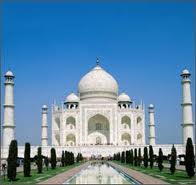Indian Architecture
 Indian Architecture is one of the most enduring works in our country. There are so many monuments that have been built in India over thousandths of years which still stand the test of time and are renowned the world over for their scale and grandeur. Indian architecture, belonging to different periods of history, bears the stamp of respective periods. Architecture progressed and evolved with time continuously assimilating influences and inspirations from others regions of the world. Tracing back to 2000 years Indian monuments reveal subtle details of Hindu, Muslim, Jain, Buddhist, Sikh and Christian styles of architecture where each religion is characterized by their own particular kind of styles coupled with cultural and mythological implications. So much so that monuments even under the same religion develop distinctly different characteristics across the various regions of India. For Ex Temples of South and North India have distinct differences in styling and preferences from one another.
Indian Architecture is one of the most enduring works in our country. There are so many monuments that have been built in India over thousandths of years which still stand the test of time and are renowned the world over for their scale and grandeur. Indian architecture, belonging to different periods of history, bears the stamp of respective periods. Architecture progressed and evolved with time continuously assimilating influences and inspirations from others regions of the world. Tracing back to 2000 years Indian monuments reveal subtle details of Hindu, Muslim, Jain, Buddhist, Sikh and Christian styles of architecture where each religion is characterized by their own particular kind of styles coupled with cultural and mythological implications. So much so that monuments even under the same religion develop distinctly different characteristics across the various regions of India. For Ex Temples of South and North India have distinct differences in styling and preferences from one another.
Serious advances in Indian architecture can be attributed to the advent of Buddhism in India during King Ashokas reign around (270- 232). Some magnificent monasteries and Stupas were built during this period.Highlights among them are the Great Sanchi Stupa and the rock cut caves of Ajantha.
Hindu Style of Architecture in India
With the consolidation of Hinduism during the eighth century Hindu style of architecture began to flourish. Some of the most popular among them are the temples of Mahabalipuram and kanchipuram. The brilliant temple of Brihadeshwara built by king Raja Raja Chola in Tanjore is one of Indias most defining landmarks. The temple is known for its huge size and scale of grandeur. Other stellar achievements include the works of the Vijaynagar kingdom one of them which is the popular Meenakshi temple in Madurai.
 In the North building styles and inspirations where different from the South. In central India, Chandella built a magnificent complex of temples at their capital. The Kajuraho temple which was built around 950- 1030 AD is still very popular tourist attraction where the art is highly admired. These temples show Vaishnavaite, Shaivite and Tantric influences. The temples have many sexual representations which is an indication of how modern our ancestors were in those days. More famous is the Surya temple at Konark built by Narasimha Deva Ganga . And many masterpieces of Indian architecture can be found in Bhubaaneshwar and Puri as well.
In the North building styles and inspirations where different from the South. In central India, Chandella built a magnificent complex of temples at their capital. The Kajuraho temple which was built around 950- 1030 AD is still very popular tourist attraction where the art is highly admired. These temples show Vaishnavaite, Shaivite and Tantric influences. The temples have many sexual representations which is an indication of how modern our ancestors were in those days. More famous is the Surya temple at Konark built by Narasimha Deva Ganga . And many masterpieces of Indian architecture can be found in Bhubaaneshwar and Puri as well.Mughal Style of Architecture in India
The Mughal architecture was another important chapter in Indian History. Over the years the mughal dynasty have built some outstanding pieces of work which will be talked about for many more centuries. Mughal emperors like Humayun, Akbar Shah Jahan and Jahangir promoted art and architecture and spent lavishly in building mausoleums, forts, palaces and other landmarks. The concentrated places of Mughal monuments can be located in Lahore, Delhi, Fatehpur Sikri and Agra. Monuments like Jama Masjid is one of the largest mosques in the world while the Red Fort today stands as a symbol of emblematic State power. Buland Darwaza, Humayuns tomb and Akbars tomb are other important landmarks.
The most exquisite among them is the Taj Mahal which features as one of the seven wonders in the world. Built entirely on white marble it was built by Shajahan for his beloved Mumtaz Mehal. The monument took twenty two years in the making and is one of the countries most frequented tourist attraction.
Unlike the Mughals, the British did not contribute much to India's architectural history. Their rule is associated mainly with having built monumental civic buildings like the Victoria Terminus in Bombay, or commemorative exercises typified by the Victoria Memorial in Calcutta. There are some wonderful examples of church architecture, such as St. James's Church in Delhi, but the main contribution of the British happens to be the construction of a new capital in Delhi.
No comments:
Post a Comment